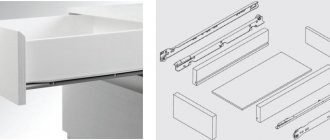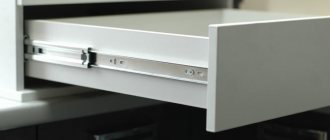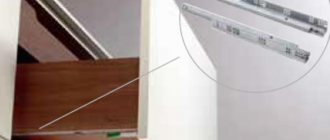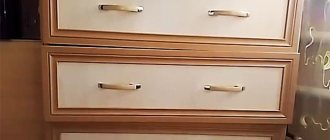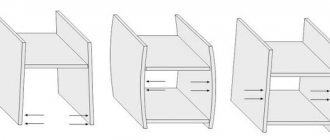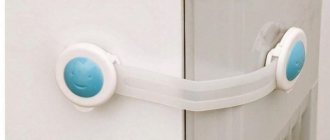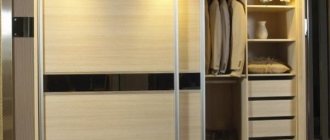Drawers, baskets, shelves are convenient, ergonomic storage places in wardrobes and dressing rooms. Retractable storage systems allow you to make the most efficient use of the interior space of the furniture, while all placed items of any size will always be “in sight” and available for search. But no matter what equipment option you choose, you will have to select the dimensions of the guides for the drawers, taking into account the nuances of installation and calculations of the dimensions of the parts, as well as the dynamic load on the mechanism.
Types of drawer guides
Any retractable mechanism of cabinet furniture is based on the operation of roller or ball guides.
Ball guides are also called “telescopic” or “telescopes” due to the principle of extending the inner part of the runners from the outer housing. They are slightly more expensive than roller ones.
ball (telescopic) guides for drawers
| Size range of ball guides, mm | ||||||
| 250 | 300 | 350 | 400 | 450 | 500 | 550 |
Roller guides are the simplest and cheapest extension mechanism: two plastic rollers slide along the slides, and when lifted into a small diagonal, they are easily removed from each other.
roller guides for drawers
| Dimensions of roller guides, mm | ||||||
| 250 | 300 | 350 | 400 | 450 | 500 | 550 |
Each of the two main types of guides has many varieties.
Retractable systems based on roller guides
For example, so-called metaboxes work on roller guides - retractable systems, which are metal sidewalls for drawers of different heights.
Metaboxes are also called metalboxes, samboxes. They can be equipped with longitudinal and transverse rails, expanded with blind and perforated inserts, and also supplemented with closers.
Most pull-out shelves and baskets for wall-mounted wardrobes and walk-in closets also roll out using a roller guide built into the hanging frame.
Retractable systems based on ball (telescopic) guides
There are also many varieties of telescopic retractable systems.
Ball guides for drawers are distinguished according to the installation method. There are overhead and mortise ones, as well as with hidden installation - in this case, the retractable mechanism is “hidden” under the bottom of the drawer box.
The system of moving the roller guides does not allow a closer to be built inside the mechanism - it can only be installed as a separate capsule and “slow down” the movement of the drawer. But ball guides with a built-in closer are implemented in a single mechanism.
Also, all roll-out baskets, cargo and other mesh storage systems with closers that ensure smooth “retraction” of the mechanism “work” due to ball guides.
Separately, it is worth highlighting the so-called tandemboxes - retractable systems with double-walled metal sides, inside of which there is a built-in ball guide with an additional “upgrade” that ensures silent smooth closing with a closer.
Tandem boxes are designed for increased load capacity; there are models with dynamic loads of up to 70-80 kg. For comparison, the load-bearing capacity of metaboxes on roller guides is about 20-30 kg.
Tandemboxes and metaboxes
These are new items. You can find them in stores quite recently. The main differences are that the guide is located inside the side metal wall, there is a closer and dampers.
Advantages - original design solution, aesthetics, ability to withstand heavy loads, ease of use, durability. Disadvantages - the use of special marking devices is required.
Roller guides for drawers, dimensions for installation, nuances of choice
The dimensions of the roller guides for drawers and storage systems are selected according to the depth of the niche in which they are planned to be installed. In this case, the assembled box should be at least 10-20mm smaller in depth. For example, in a cabinet with sidewalls 420mm deep, guides 400mm long are selected.
The size range of roller guides for drawers is presented in sizes from 250mm to 550mm (rarely more, up to 600, 650 and 700mm) in increments of 50mm.
There are mounting holes along the entire length of the rails. The distance between them obeys the well-known rule for cabinet furniture, called “system 32”. Its essence lies in the multiplicity of distances for installation to the number 16/32 - 64, 96, 128, etc.
One part of the rail with a “corner” shape is attached to the drawer, with a grip on the bottom, and the second – to the inner side of the wardrobe.
When choosing roller guides for a drawer, it is important to take into account not only the length of the rails themselves, but also the quality characteristics of the mechanism itself:
- Metal thickness. The majority of breakdowns occur due to insufficient rigidity of the rails. Drawers fall out of their grooves, bending them with their weight. To prevent this from happening, when choosing, pay attention to the thickness of the metal. It is optimal for shallow (up to 300-350mm) and low (up to 200-250mm along the facade) drawers to choose roller guides with a thickness of 1mm. For everyone else - 1.2-1.5mm.
- Load bearing capacity. Roller guides for drawers are the most inexpensive mechanism on the market. Cheapness is also determined by the obviously low requirements for ride quality, weight loads, etc. The dynamic load on the roller mechanism should not exceed 10-20 kg, taking into account the weight of the box itself (depending on the size, a drawer can weigh 3-7 kg).
If you are planning to make drawers in a wardrobe or dressing room with a larger load and quite voluminous in size, it is better to choose an equipment option among ball pullout systems. They will last much longer and will not irritate you with harshness, squeaking and noise when moving.
Classification
Roller guides are classified according to several indicators:
1) By length.
Based on unification considerations, 9 main standard sizes for guides were determined: 250mm, 270mm, 300mm, 350mm, 400mm, 450mm, 500mm, 550mm, 600mm. The selection of roller guides for a specific case is determined by the design features of the furniture element.
2) According to the thickness of the material used. The thickness of the painted roller guides ranges from 0.8mm to 1.2mm, which is determined by the load acting on this type of fittings
3) By color scheme. (photos of guides in five colors) In the modern world, only five colors are standard for this type of product. These are white, grey, black, brown and silver
4) By type of extension: partial and full extension.
Ball guides for drawers, dimensions for installation, nuances of choice
In terms of quality characteristics, ball mechanisms are much better: they are more stable, durable, provide smooth movement of the drawer and are almost silent. But they also cost a little more.
The good news is that the calculation of drawer frame dimensions for roller and ball slides is exactly the same. The size of the gap between the box frame and the sides for both types is 12.5-13mm.
That is, you can always change the roller guides to telescopic (ball) ones if for some reason you are not satisfied with the quality of the first ones.
The exception is mortise guides and hidden installation: the technological dimensions of the gaps between the box frame and the sides are calculated differently for them. In size, the hidden-mounted drawer is larger in width, and the gaps between the sidewalls and the box are smaller (by internal size -49mm versus -90mm when calculated).
There is also a difference in the installation of ball guides on a drawer: if the roller guides “cling” under the bottom, then the ball guides - along the center of the side.
The dimensions of ball guides for drawers according to the installation holes also follow the “32 system”.
When choosing ball guides for a drawer, pay attention to the size, metal thickness and load-bearing capacity of the mechanism. Thin telescopic mechanisms are more designed for installing pull-out shelves with low and medium loads. More “powerful”, wider in size are suitable for deep chest of drawers up to 900mm wide.
The design of the drawer and its internal contents can also vary in size and functionality. You can read about this here.
Full extension
Such fittings are most in demand by modern furniture manufacturers. The basis of the design is a ball bearing.
Advantages - they allow you to open the drawer smoothly and completely, the model range is quite wide. The downside is the need to be extremely careful during installation so as not to damage the parts.
